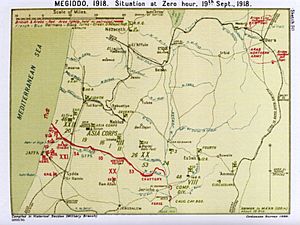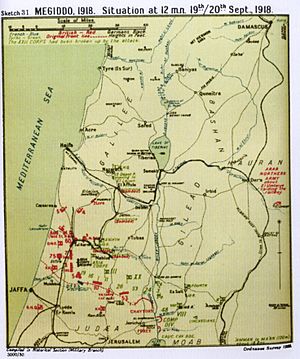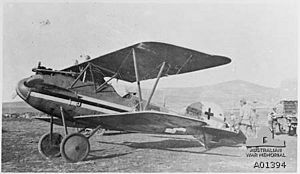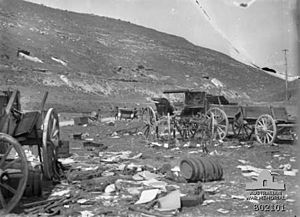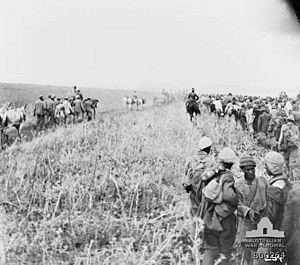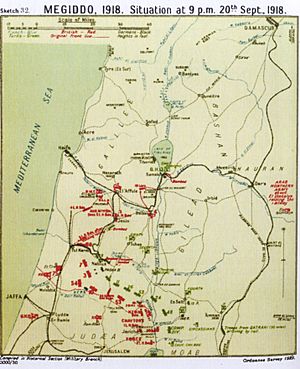Capture of Jenin facts for kids
Quick facts for kids Capture of Jenin |
|||||||
|---|---|---|---|---|---|---|---|
| Part of the Middle Eastern theatre of World War I | |||||||
 Jenin on 21 September 1918 |
|||||||
|
|||||||
| Belligerents | |||||||
| Commanders and leaders | |||||||
| Units involved | |||||||
| Egyptian Expeditionary Force Desert Mounted Corps Australian Mounted Division |
Yildirim Army Group Seventh Army Eighth Army |
||||||
| Casualties and losses | |||||||
| unknown | unknown casualties, 8,000 prisoners | ||||||
The Capture of Jenin was an important event during World War I. It happened on September 20, 1918. This battle was part of a larger plan called the Battle of Megiddo. This big battle took place in the last months of the Sinai and Palestine Campaign.
During the battle, soldiers from the Desert Mounted Corps attacked and captured the town of Jenin. Jenin is located in a valley about 50 miles (80 km) behind the front lines. Australian light horse soldiers captured about 2,000 enemy soldiers. They also took over the main supply base for the Ottoman and German armies. This cut off their supplies and escape routes.
Later, another 6,000 Ottoman and German soldiers were captured. They were trying to retreat from the Judean Hills. This victory was a big step for the British Empire. It helped them win the war in this region.
Contents
Why Jenin Was Important
The Egyptian Expeditionary Force (EEF) used its cavalry to move quickly. They rode through a gap created by their infantry near the Mediterranean Sea. Their goal was to cut off the main supply lines of the two Ottoman armies. These armies were fighting in the Judean Hills.
On September 20, 1918, the Desert Mounted Corps captured several key towns. These included Afulah, Beisan, and Jenin. Capturing these places helped trap the enemy forces.
The next day, the headquarters of the Ottoman Seventh Army was captured. Two days later, Haifa was captured. These actions led to many enemy soldiers being taken prisoner. The battles forced the remaining Ottoman armies to retreat. They moved east across the Jordan River and then north towards Damascus. The Desert Mounted Corps chased them closely.
How the Battle Started
After the infantry broke through the enemy lines, the cavalry moved forward. The Australian Mounted Division followed other cavalry units. They rode north across the Mount Carmel Range. Their goal was to reach the Esdraelon Plain.
One part of the Australian force, the 4th Light Horse Brigade, stayed behind. They guarded supplies and headquarters. The 3rd Light Horse Brigade continued to Jenin.
The 9th and 10th Light Horse Regiments captured Jenin after a short fight. They took about 8,000 Ottoman soldiers prisoner. These soldiers were trying to escape from the Judean Hills. The Australian soldiers were outnumbered but held their ground. More troops arrived to help manage the prisoners. The 3rd Light Horse Brigade stayed in Jenin. Later, they moved on to capture Tiberias.
Planning the Attack
In February 1918, General Edmund Allenby ordered his forces to take the Jordan Valley. Later, many British soldiers were sent to fight on the Western Front. New soldiers from British India Army replaced them. These new troops trained by attacking parts of the Ottoman front line. This helped them get ready for a big attack.
By mid-September, the EEF was ready for a large offensive. On September 19, the Battle of Megiddo began. British forces broke through the Ottoman lines. This started the Battle of Sharon. Another battle, the Battle of Nablus, also began.
The main goal was to trap the Ottoman armies. The cavalry divisions moved quickly to surround the enemy. They captured key towns like Nazareth, Haifa, Afulah, Beisan, and Jenin. This prevented the Ottoman forces from escaping.
Preparing for the Advance
The Desert Mounted Corps gathered near Ramleh, Ludd, and Jaffa. They left behind extra equipment. The soldiers moved close to the front lines at night. Each soldier carried food for themselves and their horses.
The 5th Cavalry Division led the advance. The 4th Cavalry Division followed, with the Australian Mounted Division in reserve. They moved through mountain passes. The goal was to reach the Esdraelon Plain. This plain was important because it had roads and railways. These were vital for the German and Ottoman armies' supplies.
The Esdraelon Plain was a key area. It stretched from Nazareth in the north to Jenin in the south. Afulah and Beisan were important hubs on the plain. The railway passed through Jenin, connecting to Ottoman army headquarters. No strong defenses were found on the plain.
On September 20, the Australian Mounted Division reached Lejjun. The 3rd Light Horse Brigade then advanced to Jenin. Their mission was to cut off the main escape route for enemy soldiers.
The Battle for Jenin
At 3:35 PM on September 20, the 3rd Light Horse Brigade was ordered to capture Jenin. The 9th and 10th Light Horse Regiments moved quickly. They were supported by artillery and armored cars.
As they approached Jenin, a small group of soldiers surprised an enemy outpost. They charged with their swords. They captured between 1,200 and 1,800 German and Ottoman soldiers.
The 10th Light Horse Regiment led the charge into Jenin. They rode directly towards the town. They quickly overwhelmed the enemy soldiers in the open. The 9th and 10th Regiments attacked from different directions. This confused the defenders. There was a short fight with machine guns. After about two hours, the Germans tried to retreat. Many were killed or captured. Around 4,000 prisoners were taken.
Jenin was a major supply base for the Ottoman armies. Huge amounts of war materials were captured. This included guns, machine guns, and ammunition. They also found food, drinks, and 24 burnt aircraft. Locomotives and workshops were captured at the railway station. Three hospitals were also taken over. Soldiers found valuable items, including champagne and gold.
After securing the town, the light horse regiments waited. They positioned themselves at the Dothan Pass. This was a main escape route from the Judean Hills. At 9:00 PM, they stopped a large column of retreating soldiers. They captured 2,800 prisoners and four guns. During the night, the light horsemen captured 8,000 prisoners in total. These soldiers were trying to escape from Nablus and Tulkarm.
What Happened Next
The 3rd Light Horse Brigade was greatly outnumbered by the prisoners. They guarded 7,075 prisoners throughout the night. Reinforcements arrived the next morning. The 4th Light Horse Brigade arrived at Jenin at 6:00 AM. They found the plain covered with prisoners, vehicles, and supplies.
The headquarters of the Australian Mounted Division arrived soon after. Other cavalry units also came to help manage the thousands of prisoners. The 8th Light Horse Regiment escorted about 7,000 prisoners to a holding camp. It took 10 hours to move them. About 14,000 prisoners were eventually held there.
The capture of Jenin was very important. All the main escape routes for the Ottoman armies were now blocked. The Desert Mounted Corps controlled the entire Esdraelon Plain. This trapped the enemy forces.
The cavalry divisions had ridden long distances. They covered many miles in a short time. They started with three days of supplies. Their supply convoys arrived on September 21.
The 5th Light Horse Brigade joined their division at Jenin on September 22. They relieved the 3rd Light Horse Brigade. On September 25, the Battle of Megiddo ended. Later that day, Tiberias was captured.
The next day, General Allenby held a meeting at Jenin. He ordered his forces to chase the enemy to Damascus. Infantry units took over guarding the captured areas. They marched through Jenin and Nazareth.


